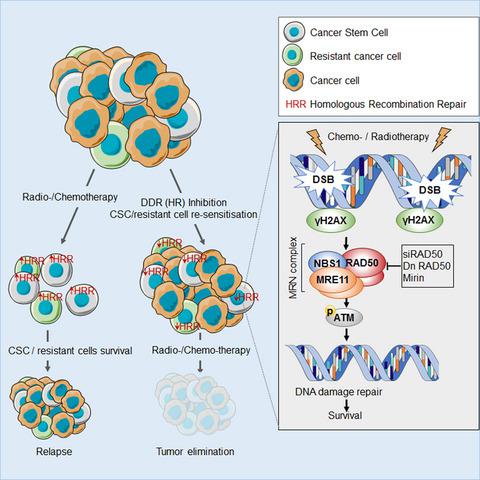Our official English website, www.x-mol.net, welcomes your feedback! (Note: you will need to create a separate account there.)
Enhanced DNA damage response through RAD50 in triple negative breast cancer resistant and cancer stem‐like cells contributes to chemoresistance
The FEBS Journal ( IF 5.4 ) Pub Date : 2020-10-08 , DOI: 10.1111/febs.15588 Etna Abad 1, 2 , Laia Civit 1 , David Potesil 3 , Zbynek Zdrahal 3, 4 , Alex Lyakhovich 1, 5
The FEBS Journal ( IF 5.4 ) Pub Date : 2020-10-08 , DOI: 10.1111/febs.15588 Etna Abad 1, 2 , Laia Civit 1 , David Potesil 3 , Zbynek Zdrahal 3, 4 , Alex Lyakhovich 1, 5
Affiliation

|
A growing body of evidence supports the notion that cancer resistance is driven by a small subset of cancer stem cells (CSC), responsible for tumor initiation, growth, and metastasis. Both CSC and chemoresistant cancer cells may share common qualities to activate a series of self‐defense mechanisms against chemotherapeutic drugs. Here, we aimed to identify proteins in chemoresistant triple‐negative breast cancer (TNBC) cells and corresponding CSC‐like spheroid cells that may contribute to their resistance. We have identified several candidate proteins representing the subfamilies of DNA damage response (DDR) system, the ATP‐binding cassette, and the 26S proteasome degradation machinery. We have also demonstrated that both cell types exhibit enhanced DDR when compared to corresponding parental counterparts, and identified RAD50 as one of the major contributors in the resistance phenotype. Finally, we have provided evidence that depleting or blocking RAD50 within the Mre11–Rad50–NBS1 (MRN) complex resensitizes CSC and chemoresistant TNBC cells to chemotherapeutic drugs.
中文翻译:

通过RAD50在三阴性乳腺癌抗性和癌干样细胞中增强的DNA损伤反应有助于化学抗药性
越来越多的证据支持以下观点:抗癌性是由一小部分癌症干细胞(CSC)驱动的,该干细胞负责肿瘤的发生,生长和转移。CSC和化学抗性癌细胞可能具有共同的特质,以激活一系列针对化学治疗药物的自卫机制。在这里,我们旨在鉴定耐化学性三阴性乳腺癌(TNBC)细胞和相应的CSC样球状细胞中的蛋白质,这些蛋白质可能有助于其耐药性。我们已经鉴定出几种候选蛋白质,它们代表DNA损伤反应(DDR)系统,ATP结合盒和26S蛋白酶体降解机制的亚家族。我们还证明,与相应的亲代对应物相比,两种细胞类型均显示出增强的DDR,并确定RAD50是耐药表型的主要贡献者之一。最后,我们提供了证据,表明Mre11–Rad50–NBS1(MRN)复合物中的RAD50耗尽或受阻,可使CSC和耐化学性TNBC细胞对化疗药物重新敏感。
更新日期:2020-10-08
中文翻译:

通过RAD50在三阴性乳腺癌抗性和癌干样细胞中增强的DNA损伤反应有助于化学抗药性
越来越多的证据支持以下观点:抗癌性是由一小部分癌症干细胞(CSC)驱动的,该干细胞负责肿瘤的发生,生长和转移。CSC和化学抗性癌细胞可能具有共同的特质,以激活一系列针对化学治疗药物的自卫机制。在这里,我们旨在鉴定耐化学性三阴性乳腺癌(TNBC)细胞和相应的CSC样球状细胞中的蛋白质,这些蛋白质可能有助于其耐药性。我们已经鉴定出几种候选蛋白质,它们代表DNA损伤反应(DDR)系统,ATP结合盒和26S蛋白酶体降解机制的亚家族。我们还证明,与相应的亲代对应物相比,两种细胞类型均显示出增强的DDR,并确定RAD50是耐药表型的主要贡献者之一。最后,我们提供了证据,表明Mre11–Rad50–NBS1(MRN)复合物中的RAD50耗尽或受阻,可使CSC和耐化学性TNBC细胞对化疗药物重新敏感。


























 京公网安备 11010802027423号
京公网安备 11010802027423号